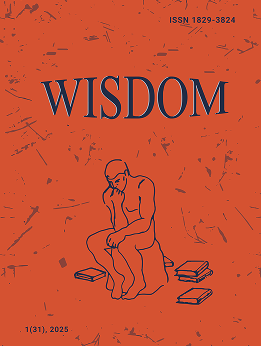Cultural Characteristic of Early Christianity
DOI:
https://doi.org/10.24234/wisdom.v7i2.160Keywords:
St. Gregory the Illuminator, Tiridates III, Constantine the Great, Constantinopole, Mesrop Mashtots, Armenian alphabet, Christianity, polytheism, historiography, ideology, religion, Christian churches, theology, natural science, rhetoric, local culture, cultural characteristic, philosophical-anthropological, socio-political, historian’s testimony, ecclesiastical literature, bibliographic monumentsAbstract
The article presents the cultural characteristic of early Christianity in Armenia. In the end of the 3rd century Christianity had a large number of followers. Christianity gave an opportunity to resist with national unity the external invaders and protect national independence and autonomy. Assessing correctly the situation, in 301 Tiridates III (287-330) by the initiative of Gregory the Illuminator declared Christianity as a state religion in Armenia. Gregory the Illuminatore could show that only due to Christianity it was possible to ensure the further history of Armenian people. He also explained the philosophical-anthropological bases of that religion, contrasting that with the visible simplicity of polytheism.
The adoption of Christianity was a powerful twist in country’s external and internal policy but it rejected by the religious aspect the faith of the centuries, the pagan culture and literature. But nevertheless, remained only pre-Christian spiritual and cultural values which were created by people.
Christianity created its culture, literature, school. In Armenia constructed Christian churches, next to them were opened Christian churches in Greek and Assyrian languages.
In the history of the Christian culture 4th and 5th centuries historical situations were the most important factors for the development of Early Medieval Armenian art and ecclesiastical literature and oriented its essence and uniqueness giving impetus to the creation of high bibliographic monuments.
Downloads
References
Azaryan, L. (1975). Vagh mijnadaryan haykakan qandaky’ (The Armenian Sculpture of Early Medieval, in Armenian), Yerevan.
Gevorgyan, H. (2001). Qristoneut’yan y’ndunumy’ Hayastanum patmut’yan p’ilisop’ayut’yan tesankyunic (Adoption of Christianity According to Philosophy, in Armenian), “Armenian army” military journal N 1-2 (27-28), 15-31.Yerevan.
Hacuni, V. Father Archimandrite. (1927). Karewor xndirner hay ekeghecwoy patmut’ene’n (The Main Problems of Armenian Church, in Armenian), Venice, St. Lazarus.
Hay jhoghovrdi patmut’yun (History of Armenian People, in Armenian). (1982). Ch. II, Yerevan.
Manandyan, H. (1978). Erker (Narratives, in Armenian). Ch.2, Yerevan.
Parpeci, Gh. (1907). Hayoc patmut’yun (History of Armenia, in Armenian). Tiflis.
Sahakyan, A. (2014). Jhoghovrdavarakan qristoneut’yuny’ mijnadaryan Hayastanum (National Christianity in Medieval Armenia, in Armenian), Yerevan.
Ter-Mkrtchyan, K. (2011). Hayoc ekeghecu patmut’jun (History of Armenian Church, in Armenian). Part 1, St. Etchmiadzin.
Yeghishe. (1904). Patmut’iwn Vardananc (The Story of Vardanants, in Armenian). Tpghis.
Downloads
Published
How to Cite
Issue
Section
License
Creative Commons Attribution-Non-Commercial (CC BY-NC). CC BY-NC allows users to copy and distribute the article, provided this is not done for commercial purposes. The users may adapt – remix, transform, and build upon the material giving appropriate credit, and providing a link to the license. The full details of the license are available at https://creativecommons.org/licenses/by-nc/4.0/.















